A temperate climate with a short summer, sudden changes in temperature, sufficient lighting is great for growing cucumbers. Therefore, almost all varieties and hybrids are cultivated in the Moscow Region. Here you can get a plentiful harvest in the first summer months, and then collect vegetables for pickling, canning until the beginning of autumn. However, you need to take into account some of the nuances of landing, leaving.
Content
Dates and grades
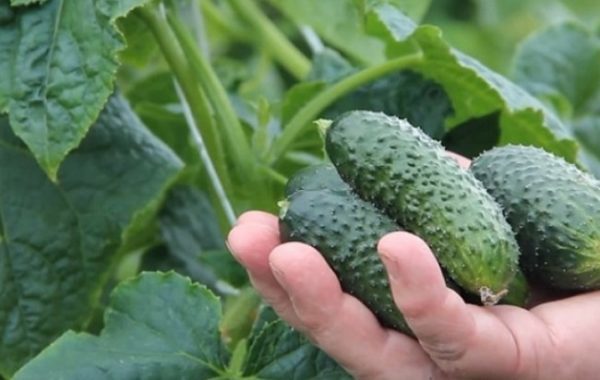 Cucumbers grow rapidly and form ovaries under certain conditions. They need moderate lighting, humidity, temperature stability. There should not be a difference of more than 15 degrees between daytime and nighttime readings. It is desirable that during the day the air warms up to at least 18 degrees, the soil to 12, and at night it can be at least 5-7 degrees. This range determines the timing of cultivation in open ground, as well as in unheated greenhouses. In the suburbs, this weather corresponds to the second half of May.
Cucumbers grow rapidly and form ovaries under certain conditions. They need moderate lighting, humidity, temperature stability. There should not be a difference of more than 15 degrees between daytime and nighttime readings. It is desirable that during the day the air warms up to at least 18 degrees, the soil to 12, and at night it can be at least 5-7 degrees. This range determines the timing of cultivation in open ground, as well as in unheated greenhouses. In the suburbs, this weather corresponds to the second half of May.
Landing dates are determined based on the characteristics of the culture, but you can focus on average values. Seeds germinate in 2-3 days, then another 30 days are needed to strengthen and grow seedlings. After you can start the landing. Soil under cover warms up 2 weeks earlier than in an open area. This means that when planting in a greenhouse, germination should be done already in early April. If it is not possible to organize a greenhouse, you can postpone the work until the 15-20th day. If you plan to land immediately in the ground, you must wait until the end of May or the beginning of June. Previously planting even cold-resistant cucumbers does not make sense, seedlings will appear only after the earth has completely warmed up.
Early cucumbers in the Moscow region rarely give a plentiful harvest, however, the fruits ripen by the middle of June. Among the hybrids most resistant to sudden freezing, there are:
- Mother-in-law dessert;
- Mom’s pet;
- Hermann.
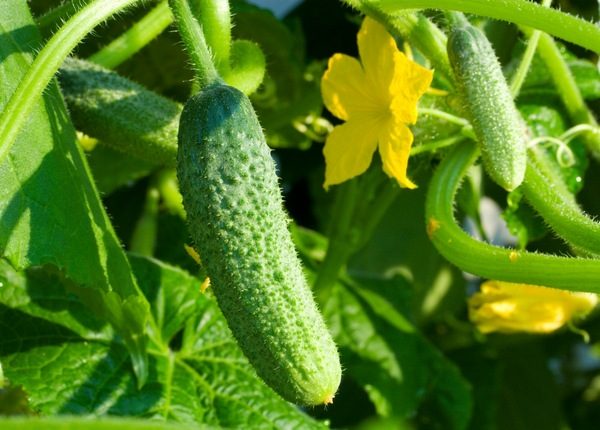
The most fruitful in the conditions of the Moscow Region will be cucumbers of the middle early type with long lashes. Shrub varieties are convenient because they take up less space, but less ovary is formed on them. The following varieties of cucumbers are often planted in open ground:
- Farmer;
- Summer resident;
- Brunet
- Hector;
- Shorty;
- Aladdin.
These are universal species that are suitable for fresh consumption, for complex compound workpieces, and for classic canning with whole fruits. These species are not planted on window sills or balconies, as they form long lashes and large green mass.
For greenhouses, including unheated ones, earlier and heat-loving varieties are suitable. You can sow cucumbers at the end of April even without seedlings. The timing of such planting must be determined based on the timing of maturation and possible conditions in the shelter. A good combination of taste and productivity have varieties:
- Zozulya
- Samurai;
- Uncle Fedor;
- Tomboy.
Landing place
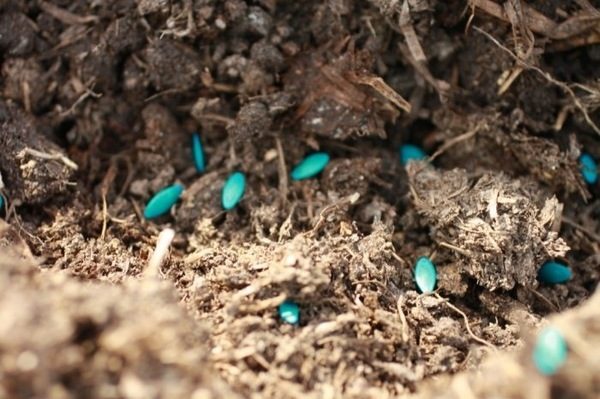
Growing different types of cucumbers in the suburbs does not require complicated soil preparation. Local loamy soil is well suited for vegetables. It is not too acidic, easily passes water. Sow culture in places with incomplete shading. It is good if the cucumbers are planted in a place where part of the day there is shelter from the sun. However, a complete shadow is unacceptable.Planting crops is necessary in a place where there is no stagnation of water. If the site is problematic from this point of view, it is better to equip an artificial hill or equip a bed with additional drainage.
Cucumbers are planted in closed or open ground only after the correct predecessor, fertilizing the ground in the fall. Manure and peat mixtures are added to the soil, they will accelerate warming up in the spring and provide necessary nutrition. You can plant any cucumbers, both bushy and climbing, in the beds after cabbage, carrots, potatoes. Do not use the place after legumes or onions. They have similar diseases, the causative agents of which can destroy new plantings.
Varietal cucumbers are planted in those areas where they were digging. In almost the entire territory of the Moscow Region, the soil has medium density, but is quickly absorbed by water, so even after one season without treatment it becomes excessively heavy. It is advisable to dig the site in the fall, and then apply fertilizer and conduct the treatment again in the early spring.
Growing methods
Cucumbers, even early ones, are not planted in open ground in the suburbs before May. This significantly limits the possibilities of cultivation throughout the year. Therefore, gardeners prepare seedlings of hybrid resistant cucumbers in advance, equip the beds in greenhouses and even master unusual cultivation methods on balconies and window sills. Each type of landing has its own characteristics.
Open ground
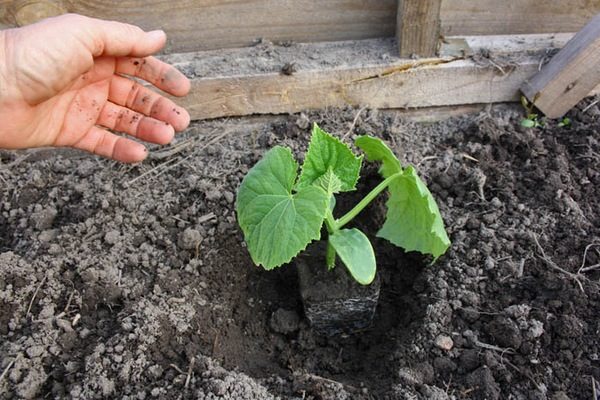
You can sow cucumbers in open ground with both seeds and seedlings. In this case, the time of work may not vary. Already grown bushes will bear fruit earlier, while seed plants will allow you to harvest continuously until the beginning of autumn. The cultivation of cucumbers of various varieties in open ground in the suburbs requires the preparation of the soil with canopy. In the spring, it is almost impossible to do this on time, as the soil dries out completely too late.
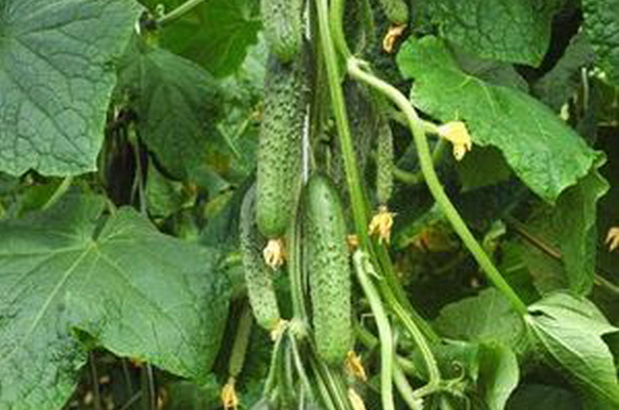 You may be interested in:
You may be interested in:Digging, fertilizing:
- superphosphates;
- humus;
- peat;
- organics.
In open ground, it is better to equip the bed in advance and prepare the supports. Using the trellis method It will allow not only to reduce the area occupied by the whips, but also to avoid infection with some diseases, decay, and soil erosion under dense foliage. Since in the summer months near Moscow sunny days alternate with cloudy ones, tying up cucumbers can also improve illumination.
After planting and top dressing, it is necessary to find the optimal frequency of watering, this is important when growing in open ground, since the rate of evaporation of moisture and drying of the earth is higher. In hot weather, watered daily, in cloudy weather - once every three days. All manipulations with the bushes are carried out early in the morning or late in the evening. It is necessary to regularly trim and form lashes or bushes. So you can grow enough vegetables without involving vast territories. After the first cucumbers have already ripened, the first leaves and stepsons are removed. Then gradually lash the whip to reduce the number of useless sheets. In this case, from one to three stems are formed on a vertical trellis depending on the variety. High landing density in the suburbs is not recommended due to lack of natural light.
Since the cultivation period in open ground is limited to only a few months, it is necessary regular feeding. This also applies to such unusual methods as growing cucumbers in a special barrel, in boxes. In the first weeks, an infusion of freshly cut grass and mullein in a ratio of 1: 1 is used as fertilizer. The concentrate is diluted with water five times, watered once a week, one liter is enough for the plant. Once a month, potassium monophosphate is added in an amount of 20 grams. Replace the additive with infusion of wood ash.
Greenhouse
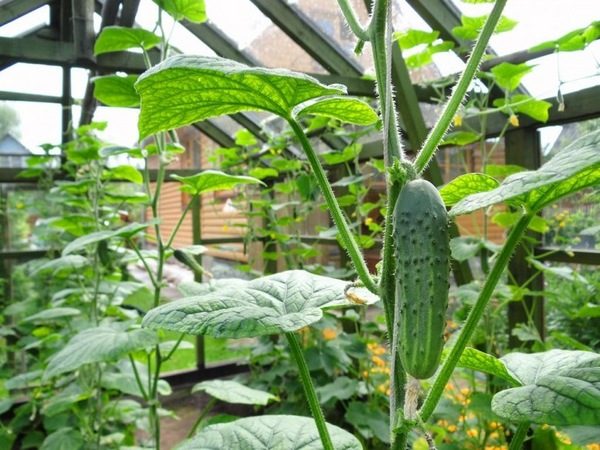
Caring for a plant in a greenhouse practically does not differ from that in open ground. Use better determinant hybrids. Their growth is limited by the appearance of flowers on the tops of the heads. Therefore, there is no need to constantly trim.
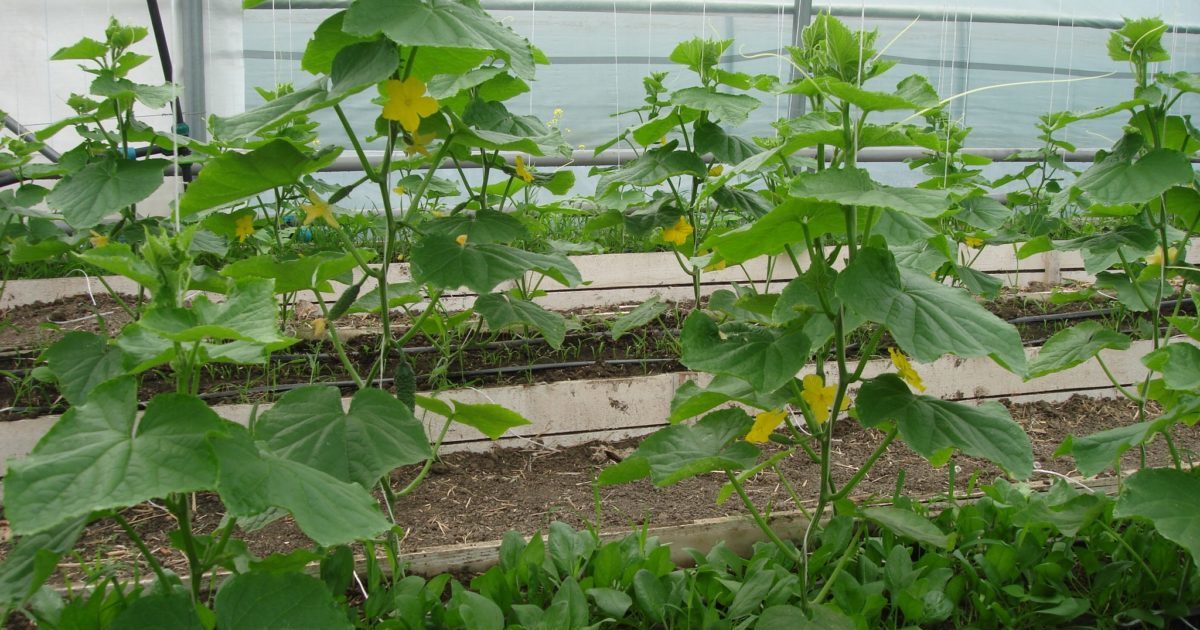 You may be interested in:
You may be interested in:After the cucumbers are planted, it is important not to forget about the need for ventilation and humidity control. When a stable daytime temperature is established, it is important to open the walls or roof of the greenhouse. The optimum mode for ripening: 23-26 degrees during the day and 18-22 at night. it is advisable to avoid drafts, however, soil eruption and cucumber whip burnout are even more dangerous. It is important to maintain humidity at around 90 percent. In the evening, spraying with warm water. Additionally, wide containers are placed in the greenhouse. The automatic irrigation system copes well with the task.
House
Unusual small hybrids are great for growing cucumbers at home. The bush will fit not only on the balcony, but also on the windowsill. In the Moscow region there is not enough natural light, especially in autumn and winter, so it is necessary to provide additional sources of UV rays. In vegetables grown in this way, the fruits are noticeably smaller in size, but the differences in taste are insignificant. Ultra-early short-fruited self-pollinating species are well suited for such conditions:
- Goosebumps;
- Sail;
- Regina
- Carmen
- Crunch.
The minimum capacity is 5 liters. The best place to place is the south and southeast windows. When planting, drainage is provided in the form of small pebbles, expanded clay. Plant seeds begin in January. In this case, in March, you can harvest the first crop.
Feeding is carried out once every two weeks. Use combined mineral and organic mixtures in small concentrations. Regular spraying of greens is also necessary, as it replaces the natural process of irrigation with condensate in the greenhouse or dew in the open ground. In small containers, diseases can quickly develop and bacteria multiply. Therefore, regular treatment is carried out with a weak solution of potassium permanganate.
Seedlings
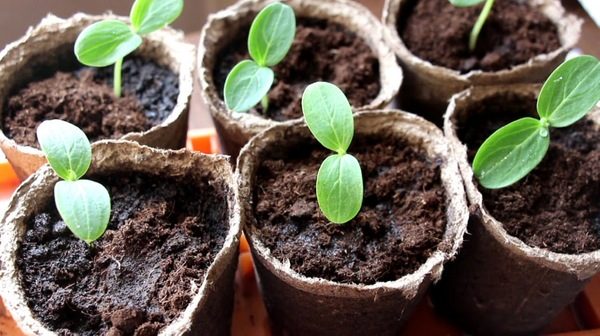
In the conditions of the Moscow Region, the seedling method allows you to get a rich harvest even in not very favorable weather already in June. Since the first summer months are characterized by the highest illumination, but unstable temperature, it is important to minimize damage to the plant during transplantation. The seedlings that were planted along with the auxiliary packaging are much better. It can be peat pots, coconut tablets, soil bags.
For planting, it is better to use a mixture of peat, turf, earth, humus and sand in equal proportions. Cucumber seeds are pre-disinfected, tempered in the refrigerator. This will help the plant survive the sudden cold snap and temperature fluctuations, which are not uncommon in the Moscow region even in the midst of summer. After the appearance of the first shoots, backlighting begins. The optimal duration of daylight for rapid development is from 14 to 16 hours a day. Two weeks before the transplant, they begin hardening.First, they lower the temperature in the room to 16-14 degrees, then take them out to the balcony for 3-4 hours at a temperature of no lower than 10 degrees and no higher than 14. Otherwise, care for the seedlings of cucumbers is required standard, as for any vegetable.
Care Secrets
A temperate climate is good for cucumbers, however, the alternation of rainy and arid seasons, cold nights can cause the death of both the plants themselves and the crop. Watering is carried out in advance with heated water. When growing at home, only filtered or boiled liquid is used, since chlorine can damage the root system. Also sprayed only with warm water. Cold slows down the development of foliage, the formation of ovaries.
Near large cities, in densely populated areas, the problem of the lack of the required number of pollinators often arises. There are simply no insects. In the Moscow region, their number is small, so you need to either use the methods of manual transfer of pollen, or to attract insects. During the flowering period, plants are sprayed with a solution of honey: 1 teaspoon per 1 liter of warm water. You can plant coriander next to the bed in spring, this will attract pollinators.
At night, the temperature drops, and in the morning moisture settles on the soil and plants. Therefore, all manipulations on trimming, shaping should be carried out only early in the morning. During the day, all sections dry up, close. This reduces the risk of bacterial and fungal infections. diseases.
Harvesting
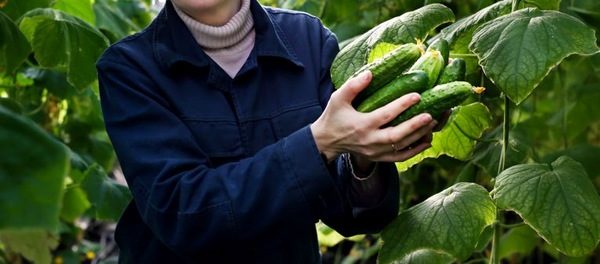
To stimulate the active formation of ovaries and rapid growth, it is necessary to start harvesting early. The first cucumbers in the greenhouse should be harvested in April or early May, in the open ground already in the second half of June. Even small fruits need to be harvested. During this period, the plant should throw all its strength into enhancing flowering and the growth of lashes.
It is better to pick cucumbers early in the morning. In this case, you need to carefully twist the green process, and not pull. This will help to avoid damage to the whip or root system in a young plant. In the first month of growth, it is advisable to harvest once every 3 days, then daily. A close inspection of the bush is very important. If the plant has many large and yellowed fruits, growth will stop. After the ripening of the seeds, a signal arrives that the vegetation is no longer required, a gradual withering begins.
Growing cucumbers in the suburbs is not very difficult even for a beginner gardener. Weather conditions allow you to get a sufficient crop even without shelter. If you plant and temper seedlings in early spring, you can get an early crop in June. However, with proper care, adherence to agrotechnical deadlines, you can grow strong, resistant bushes even from seeds. All year round you can collect your own vegetables in the suburbs not only in the greenhouse, but also on the windowsill or on the balcony. To get an excellent crop, to avoid the defeat of fungus and diseases will help the advice of experienced gardeners regarding care.




 Do-it-yourself vertical beds for cucumbers: schemes, photos
Do-it-yourself vertical beds for cucumbers: schemes, photos Hollow cucumbers: reasons for the appearance of hollow, what to do
Hollow cucumbers: reasons for the appearance of hollow, what to do Which manure is best for cucumbers: application, how to breed
Which manure is best for cucumbers: application, how to breed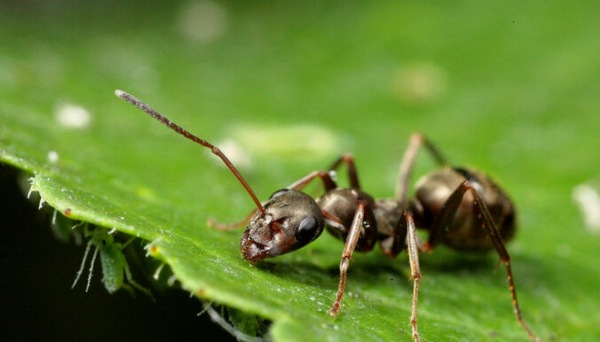 How to quickly get rid of ants on beds with cucumbers
How to quickly get rid of ants on beds with cucumbers